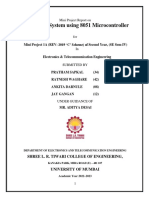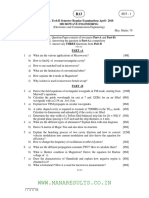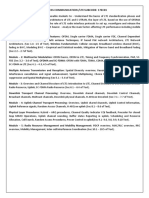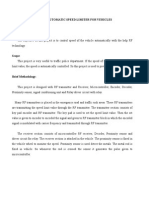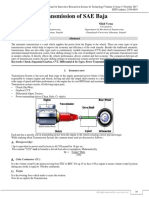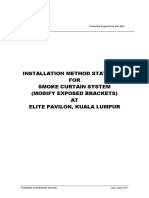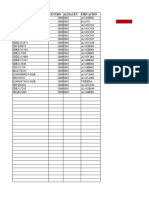Automatic Ration Distribution by Using Raspberry Pi
Automatic Ration Distribution by Using Raspberry Pi
Uploaded by
IJIRSTCopyright:
Available Formats
Automatic Ration Distribution by Using Raspberry Pi
Automatic Ration Distribution by Using Raspberry Pi
Uploaded by
IJIRSTOriginal Title
Copyright
Available Formats
Share this document
Did you find this document useful?
Is this content inappropriate?
Copyright:
Available Formats
Automatic Ration Distribution by Using Raspberry Pi
Automatic Ration Distribution by Using Raspberry Pi
Uploaded by
IJIRSTCopyright:
Available Formats
IJIRST International Journal for Innovative Research in Science & Technology| Volume 3 | Issue 11 | April 2017
ISSN (online): 2349-6010
Automatic Ration Distribution by using
Raspberry Pi
Miss. Swati V. Birje Mr. Ganesh Kadam
Assistant Professor Student
Department of Electronics & Telecommunication Engineering Department of Electronics & Telecommunication Engineering
RMCET, Ambav (Devrukh), Ratnagiri, India RMCET, Ambav (Devrukh), Ratnagiri, India
Mr. Devkumar Mohite Miss. Vishakha Veldurkar
Student Student
Department of Electronics & Telecommunication Engineering Department of Electronics & Telecommunication Engineering
RMCET, Ambav (Devrukh), Ratnagiri, India RMCET, Ambav (Devrukh), Ratnagiri, India
Mr. Uddesh Jalgaonkar
Student
Department of Electronics & Telecommunication Engineering
RMCET, Ambav (Devrukh), Ratnagiri, India
Abstract
Public distribution system (PDS) i.e. Ration distribution system is the facility provided by the Government of India to ration card
holders for food grains, fuel and other goods, as per the economic policy. Every family has its own ration card. The type of
Ration card depends on annual income of that family. In existing PDS, subsidized food grains like wheat, rice etc. and fuel like
kerosene are issued manually. So there are chances of human errors like wrong entry in register of ration shop about the amount
of food grains given to the ration card holder/user. Similarly unsold food grains at the end of the month, will sale to another users
without any intimation to the government and ration card holders, leads to illegal activity and corruption. To restrict such illegal
activities and corruption we proposed a system called Automatic Ration Distribution by using Raspberry Pi. In this system we
reduced human efforts for distributing food grains by using Raspberry Pi and GSM technology thereby informing each and every
activity to the ration card holder as well as Government. In our approach initially we are scanning QR code on Aadhar card
instead of ration card. Then Raspberry Pi matches the user QR code and OTP for authentication purpose. If user is authenticated
person then he/she will get details of allocated ration on monitor display. Then he/she will purchase the required amount of
ration by entering amount through keyboard. After completion of this process Raspberry Pi will send the information to
government server and user via GSM module.
Keywords: Aadhar Card, GSM, Public Distribution System, Raspberry pi
_______________________________________________________________________________________________________
I. INTRODUCTION
Fig. 1.1: Users in queue for purchasing of ration
All rights reserved by www.ijirst.org 196
Automatic Ration Distribution by using Raspberry Pi
(IJIRST/ Volume 3 / Issue 11/ 035)
Public distribution system in India is the largest ration distribution network which provides subsidized food grains like wheat,
rice, cereals etc. and fuel like kerosene to the ration card holder as per the policy of Government. The goal of ration distribution
system is distribution of ration across the country with proper amount. For achievement of this goal, ration shops are provided to
urban, suburban and rural areas. But this existing system has various drawbacks due to the intervention of human which leads to
illegal selling of ration and corruption. Many times users are unaware of the availability of ration. That is why shopkeeper may
sale ration at higher rates than quoted by the government. Because manpower is the only mean involved in distribution of ration,
this system becomes time consuming. Similarly most of the time users have to wait in queue for purchasing of ration, which is
shown in figure 1.1
So we proposed a system called Automatic Ration distribution using Raspberry Pi.
II. EXISTING PUBLIC DISTRIBUTION SYSTEM IN INDIA
In existing public distribution system of India, lots of work is carried out manually. E.g. Manual entry in ration shop register,
ration card etc. which leads to occurrence of human errors. Similarly there is no any kind of mean to directly convey users
regarding the exact amount of allocated ration from the government end. The information regarding allocated ration as well as
rate of the food grains and other goods is available in the Government portal but not every people residing rural area is familiar
to access web portal, this information will not reach to them. So due to the lack of transparency there are chances of happening
unfair activities. In order to overcome such limitations there should be improvement in such public distribution system so that
ration card holders will get benefited. The figure 2.1 given below shows targeted Public Distribution System Retail price per kg
[1].
Table 2.1: Targeted Public Distribution System Retail price per kg.
As per the survey with a network of more than 4 lakh Fair Price Shops claiming to distribute annually, commodities worth
more than Rs 15,000 crore to about 16 crore families.[2] The table 2.1 shown below indicates food grain allocation in India
under TPDS schemes[3].
Fig. 2.1: chart showing food grain allocation in India under TPDS schemes [2]
All rights reserved by www.ijirst.org 197
Automatic Ration Distribution by using Raspberry Pi
(IJIRST/ Volume 3 / Issue 11/ 035)
In existing system subsidized food grains are distributed manually in ration shops. Therefore many times there are chances of
human errors to be occurred.
III. PROPOSED SYSTEM
In our proposed system, we are going to remove drawbacks of existing system. This system is user friendly just like an ATM
machine. In our system we used GSM module which is interfaced to Raspberry Pi. It is used to exchange information/message
regarding allocated ration provided by government database and Raspberry Pi. When we start our system, initially message will
be sent to all registered users in the database via GSM module. Here we used SIM900A GSM module. This is compact and
reliable wireless module. The Message consists of allocated ration and OTP for that user. Whenever user is interested to buy
subsidized food grains, scanning of QR code of his/her Aadhar card is done instead of using ration card, for authentication
purpose which is shown below in figure 3.1
Fig. 3.1: Scanning of QR code of Aadhar Card and displaying stored information of user
When we scan Aadhar card it will match with the stored information of user, in the database using Raspberry Pi. This Aadhar
Card is linked with the database of government server as well as to the machine where the user is going to enter the required
amount of ration. Aadhar card and OTP are used for the security purpose. The right side portion of figure 3.1 indicates the
message Enter the password. Here user has to enter OTP as password. This system provides the digital data storage. So it
avoids lots of paper work, and gives the transparency between user and government.
The scanned information of card holder is matched with the already stored details with the help of Raspberry-Pi, for
authentication purpose. Later user will enter password to get details of allocated ration on display. Then user will enter the
required amount of ration through keyboard. Depending upon the requirement of food grains the respective container valve will
open. (E.g. if users are allocated food grains like wheat and rice we have to use two containers.) The valve will remain open until
the weight sensed by weight sensor matches with the entered amount of food grains. Once weight is matched valve will be
closed. This is how user will purchase his/her ration. After completion of this process Raspberry Pi will send the information to
government server and user through GSM module. The proposed system is shown in figure 3.2
Fig. 3.2: Proposed System
All rights reserved by www.ijirst.org 198
Automatic Ration Distribution by using Raspberry Pi
(IJIRST/ Volume 3 / Issue 11/ 035)
Hardware and Software Used
Our system consist of hardware entities like web camera, Raspberry pi, monitor, keyboard, DC motors, weight sensors,
PC(Server), power supply, GSM module and Mobile. Web camera, keyboard, monitor, motors, weight sensors, GSM module
etc. are interfaced to Raspberry Pi. Therefore Raspberry Pi is heart of our system. Here we used Raspberry Pi 3, which is shown
below in figure 4.1
Fig. 4.1: Raspberry Pi 3
The Raspberry Pi 3 is the third generation Raspberry Pi[4]. It is more flexible than ever, with a boost in processor speed and
extra wireless connectivity. Along with the wireless improvements, the processor has been given a boost, with the Raspberry Pi 3
now featuring a 64-bit, 1.2GHz quad-core Broadcom BCM2837 SoC based on ARM's Cortex-A53 CPU architecture [5]. Web
camera is used to scan QR code of Aadhar card. The scanned information is sent to Raspberry Pi where it is matched with the
stored information of users. When user enters OTP as password, it is matched with the stored OTP by Raspberry Pi. If it matches
then allocated ration will be displayed on the monitor. Keyboard is used to enter the required amount of ration by the user. After
entering the required amount of ration, the respective food grains are placed in the container. DC motors are used for opening
and closing of valves of the container as per the weighing of required amount of ration. Weight sensors are used for sensing the
weight of the ration and to forward this information to Raspberry Pi. Information about users and ration is stored in the database
of server. Finally GSM module is used to send information about purchased ration and remaining ration in the form of message
to users. Also centralized government database will be updated accordingly.
We used softwares like SD formatter, WIN 32, VNC server and Python. SD formatter is used to format SD card. SD Card
Formatter provides quick and easy access to the full capabilities of your SD cards. [6]. SD card is needed to store Operating
System. We used WIN 32 API. Almost all Windows programs interact with the Windows API [7]. In order to facilitate remote
operation of the system we used VNC server. Virtual Network Computing (VNC) is a graphical desktop sharing system that uses
the Remote Frame Buffer protocol (RFB) to remotely control another computer. It transmits the keyboard and mouse events
from one computer to another, relaying the graphical screen updates back in the other direction, over a network [8].
Programming is done by using Python. Python is a powerful programming language with high-level data structure. It is used for
rapid application development in many areas on most of the platforms. It is also suitable as an extension language for
customizable applications [9].
IV. CONCLUSION
In this paper, we explained how existing public/ration distribution system can be improved by using Aadhar card and
technologies like Raspberry Pi and GSM. Our Automatic ration distribution system will help in maintaining the transparency
between users, shop keepers and Government. So it will eliminate the limitations of existing system like illegal activity and
corruption. Automatic approach will also facilitate reduction in paper work.
REFERENCES
[1] http://mahafood.gov.in/website/english/home.aspx
[2] http://epds.nic.in
[3] http://pdsportal.nic.in
All rights reserved by www.ijirst.org 199
Automatic Ration Distribution by using Raspberry Pi
(IJIRST/ Volume 3 / Issue 11/ 035)
[4] https://www.raspberrypi.org/products/raspberry-pi-3-model-b/
[5] http://www.alphr.com/raspberry-pi/1002813/raspberry-pi-3-review-a-faster-processor-plus-bluetooth-and-built-in-wi-fi-take
[6] https://www.sdcard.org/downloads/formatter_4/
[7] https://en.wikipedia.org/wiki/Windows_API
[8] https://en.wikipedia.org/wiki/Virtual_Network_Computing
[9] https://docs.python.org/2.7/
All rights reserved by www.ijirst.org 200
You might also like
- AI-Powered Smart Glasses For Blind Deaf and DumbDocument6 pagesAI-Powered Smart Glasses For Blind Deaf and DumbMuhammad Huzaifa AmjadNo ratings yet
- IOT Based Social Distancing and Monitoring Robot For QueueDocument8 pagesIOT Based Social Distancing and Monitoring Robot For QueueIJRASETPublicationsNo ratings yet
- Two - Diet PlanDocument1 pageTwo - Diet PlanmanavchopraNo ratings yet
- Ahb To Apb NotesDocument13 pagesAhb To Apb NotesAbhimanyuNo ratings yet
- Report On Microcontroller Based Anesthesia InjectorDocument15 pagesReport On Microcontroller Based Anesthesia Injectornagalakshmi_reddy100% (1)
- Day 01 - Session 03 - AICTE ATAL FDP On Internet of ThingsDocument55 pagesDay 01 - Session 03 - AICTE ATAL FDP On Internet of ThingsLokesh Sharma100% (1)
- Fingerprint Based Electronic Voting MachineDocument20 pagesFingerprint Based Electronic Voting MachineAnjali yadavNo ratings yet
- Revised Blooms Taxonomy Action VerbsDocument1 pageRevised Blooms Taxonomy Action VerbsAbdul ShakoorNo ratings yet
- Design and Construction of LED Matrix DisplayDocument7 pagesDesign and Construction of LED Matrix DisplayTseren TsekuNo ratings yet
- Prototyping: Prototyping: Prototypes and Production - Open Source Versus Closed SourceDocument14 pagesPrototyping: Prototyping: Prototypes and Production - Open Source Versus Closed Sourcerajeswarikannan0% (1)
- Yellow DC 3V-6V Gear Motor For Intelligent Car TT Robot Motor Wheels TT MotorDocument5 pagesYellow DC 3V-6V Gear Motor For Intelligent Car TT Robot Motor Wheels TT MotorDwayne100% (1)
- 8051 PRJDocument25 pages8051 PRJParthNo ratings yet
- Technical Specifications:: Over Speed & Unauthorized Vehicle Detection Using Ir Based Speed SensorsDocument3 pagesTechnical Specifications:: Over Speed & Unauthorized Vehicle Detection Using Ir Based Speed Sensorshamed razaNo ratings yet
- Unit-4: Iot Architecture and ProtocolsDocument22 pagesUnit-4: Iot Architecture and ProtocolsMahesh ChauhanNo ratings yet
- Microwave Engineering Solutions ManualDocument4 pagesMicrowave Engineering Solutions ManualNomesh EtikalaNo ratings yet
- Question Bank: Department of Information TechnologyDocument14 pagesQuestion Bank: Department of Information TechnologyNivithaNo ratings yet
- LCD and Keyboard Interfacing: Unit VDocument21 pagesLCD and Keyboard Interfacing: Unit VrushitaaNo ratings yet
- 8051 Microcontroller Programming in KeilDocument8 pages8051 Microcontroller Programming in KeilSenthil Kumar SNo ratings yet
- Module 1 Notes (17EC81)Document16 pagesModule 1 Notes (17EC81)gagan mrNo ratings yet
- 8085 Microprocessor InterruptsDocument33 pages8085 Microprocessor InterruptsAASTHA KIETNo ratings yet
- 18ec61 DCDocument146 pages18ec61 DCSadashiv BalawadNo ratings yet
- Micro Controller Based Digital Visitor CounterDocument33 pagesMicro Controller Based Digital Visitor Counterprathameshas90No ratings yet
- CHAPTER 04: Peripherals Interfacing With 8086 and ApplicationsDocument17 pagesCHAPTER 04: Peripherals Interfacing With 8086 and ApplicationsAnikhet MulkyNo ratings yet
- Chapter5 NETWORK LAYERDocument86 pagesChapter5 NETWORK LAYERmuniNo ratings yet
- Case Study 8086 MicroprocessorDocument4 pagesCase Study 8086 MicroprocessorVitesh ShengaleNo ratings yet
- Ece IV Microcontrollers (10es42) NotesDocument121 pagesEce IV Microcontrollers (10es42) NotesSoujanya Rao KNo ratings yet
- Ipv6 Examples NumericalsDocument8 pagesIpv6 Examples NumericalsAbhishek RegmiNo ratings yet
- 10 BDocument24 pages10 Bhassan_said_8No ratings yet
- Embedded System LESSONPLANDocument7 pagesEmbedded System LESSONPLANgallantprakashNo ratings yet
- Smart Real Time Health Monitoring System Using ArduinoDocument5 pagesSmart Real Time Health Monitoring System Using ArduinoSDS PRIORNo ratings yet
- Automatic Engine Locking System Through Alcohol Detection For Drunken DriversDocument44 pagesAutomatic Engine Locking System Through Alcohol Detection For Drunken Driversyakshithreddy000No ratings yet
- Unit 1Document59 pagesUnit 1ayush charde 786No ratings yet
- IoT Lab REPORT CSEDocument20 pagesIoT Lab REPORT CSECaptains PlayNo ratings yet
- SRSA. Ppt-1Document15 pagesSRSA. Ppt-1Santhoshi RupaNo ratings yet
- Smart Monitoring of The Train and Train Tracks To Prevent Railway HazardsDocument25 pagesSmart Monitoring of The Train and Train Tracks To Prevent Railway HazardsviswaNo ratings yet
- IoT Based Health Monitoring System Using Machine LearningDocument6 pagesIoT Based Health Monitoring System Using Machine LearningMaheshkumar AmulaNo ratings yet
- IOT Project Report: Solar Panel Monitoring SystemDocument13 pagesIOT Project Report: Solar Panel Monitoring SystemAnushka ShahNo ratings yet
- Bi-Directional Visitor Counter Using IotDocument109 pagesBi-Directional Visitor Counter Using IotManikanta GuttulaNo ratings yet
- Model Questionpaper - Paper2Document3 pagesModel Questionpaper - Paper2Shubhra DixitNo ratings yet
- 04 Chapter 1 - PLCDocument36 pages04 Chapter 1 - PLCsaliana binti sanusi100% (3)
- NATL Notes Unit2Document10 pagesNATL Notes Unit2TejaNo ratings yet
- Design of Frequency Reconfigurable Micro-Strip Antenna: A Project ReportDocument38 pagesDesign of Frequency Reconfigurable Micro-Strip Antenna: A Project ReportSubramanian ANo ratings yet
- IOT Based Sanitization RobotDocument27 pagesIOT Based Sanitization RobotBhanu TummalapalliNo ratings yet
- C-LIENet - A Multi-Context Low-Light Image Enhancement NetworkDocument12 pagesC-LIENet - A Multi-Context Low-Light Image Enhancement NetworkSubhankar Chakraborty ee17b031No ratings yet
- Automated Height Based Box Sorting System Using PLC: Project OnDocument36 pagesAutomated Height Based Box Sorting System Using PLC: Project OnKetan KundiyaNo ratings yet
- "Automatic Railway Crossing Gate Control ": A Project Report OnDocument80 pages"Automatic Railway Crossing Gate Control ": A Project Report Ondarshan_dharajiaNo ratings yet
- "Iot Based Smart Public Distribution System": A Micro Project Report OnDocument25 pages"Iot Based Smart Public Distribution System": A Micro Project Report OnSandesh PathareNo ratings yet
- Consumer Electronics PDFDocument22 pagesConsumer Electronics PDFXYZNo ratings yet
- Deepa PPT 49Document20 pagesDeepa PPT 49deepaNo ratings yet
- Mini Project Presentation On: Bidirectional Visitor Counter With GSM ModuleDocument26 pagesMini Project Presentation On: Bidirectional Visitor Counter With GSM ModuleSYED SHABAZ 1DS19EC438No ratings yet
- Solar Based Garbage Cleaning BoatDocument4 pagesSolar Based Garbage Cleaning BoatPoonam KilaniyaNo ratings yet
- Ei Project ReportDocument18 pagesEi Project ReportSadhana PalleNo ratings yet
- Fire Fighting Bot To Allow A User To Control A Fire Fighter RobotDocument23 pagesFire Fighting Bot To Allow A User To Control A Fire Fighter RobotLumisense TechnologiesNo ratings yet
- 8K Resolution Camera SystemDocument51 pages8K Resolution Camera SystemRutuja PawarNo ratings yet
- Smart Parking System Based On Rfid and GSM TechnologyDocument6 pagesSmart Parking System Based On Rfid and GSM TechnologyJames Ligab0% (1)
- Main PPT Speed Control System With Rfid Equipped VehicleDocument27 pagesMain PPT Speed Control System With Rfid Equipped VehicleSujatha GoliNo ratings yet
- 2... Vijay-Advanced Security Systems in Jewellery Shops and Banks PDFDocument97 pages2... Vijay-Advanced Security Systems in Jewellery Shops and Banks PDFShanker PandeyNo ratings yet
- Presentation On Basic VlsiDocument16 pagesPresentation On Basic VlsidivyaniNo ratings yet
- RF Based Automatic Speed Limiter For VehiclesDocument35 pagesRF Based Automatic Speed Limiter For Vehiclesv3rajasekarNo ratings yet
- The Today and Future of WSN, AI, and IoT: A Compass and Torchbearer for the TechnocratsFrom EverandThe Today and Future of WSN, AI, and IoT: A Compass and Torchbearer for the TechnocratsNo ratings yet
- Satellite Dish Positioning SystemDocument5 pagesSatellite Dish Positioning SystemIJIRST100% (1)
- Patterns of Crop Concentration, Crop Diversification and Crop Combination in Thiruchirappalli District, Tamil NaduDocument10 pagesPatterns of Crop Concentration, Crop Diversification and Crop Combination in Thiruchirappalli District, Tamil NaduIJIRSTNo ratings yet
- Arduino-UNO Based Magnetic Field Strength MeasurementDocument4 pagesArduino-UNO Based Magnetic Field Strength MeasurementIJIRSTNo ratings yet
- Currency Recognition Blind Walking StickDocument3 pagesCurrency Recognition Blind Walking StickIJIRSTNo ratings yet
- Social Impact of Chukha Hydro Power On Its Local Population in BhutanDocument2 pagesSocial Impact of Chukha Hydro Power On Its Local Population in BhutanIJIRSTNo ratings yet
- Literature Review For Designing of Portable CNC MachineDocument3 pagesLiterature Review For Designing of Portable CNC MachineIJIRSTNo ratings yet
- Development of Tourism Near Loktak Lake (Moirang) in Manipur Using Geographical Information and Management TechniquesDocument4 pagesDevelopment of Tourism Near Loktak Lake (Moirang) in Manipur Using Geographical Information and Management TechniquesIJIRSTNo ratings yet
- Transmission of SAE BajaDocument5 pagesTransmission of SAE BajaIJIRST100% (1)
- Analysis and Design of Shear Wall For An Earthquake Resistant Building Using ETABSDocument7 pagesAnalysis and Design of Shear Wall For An Earthquake Resistant Building Using ETABSIJIRSTNo ratings yet
- Modeled Sensor Database For Internet of ThingsDocument4 pagesModeled Sensor Database For Internet of ThingsIJIRSTNo ratings yet
- Automated Online Voting System (AOVS)Document4 pagesAutomated Online Voting System (AOVS)IJIRSTNo ratings yet
- Analysis of Fraudulent in Graph Database For Identification and PreventionDocument8 pagesAnalysis of Fraudulent in Graph Database For Identification and PreventionIJIRSTNo ratings yet
- Fireye NEX-1502 Comfire SoftwareDocument46 pagesFireye NEX-1502 Comfire SoftwaresarkaftNo ratings yet
- Lesson 3:creative Nonfiction and DramaDocument7 pagesLesson 3:creative Nonfiction and DramaRaymond ZafraNo ratings yet
- 15 Monitoring Part4 01Document6 pages15 Monitoring Part4 01Sheroze MasoodNo ratings yet
- 10 Quiz 1Document2 pages10 Quiz 1Miguel Vienes100% (1)
- Documentation SampleDocument26 pagesDocumentation SampleOm BhandariNo ratings yet
- Elite Pavilion - Method Statement - Smoke Curtain (Adjust Brackets) PDFDocument6 pagesElite Pavilion - Method Statement - Smoke Curtain (Adjust Brackets) PDFJuwe PkdoNo ratings yet
- Cambio de Ubicaciones Sede CuscoDocument62 pagesCambio de Ubicaciones Sede CuscoClinton Maico MezaNo ratings yet
- J&T ExpressDocument1 pageJ&T ExpressDiane SaibonNo ratings yet
- GrotopDocument4 pagesGrotopHuda FiqiNo ratings yet
- Catalog Implants EsmicoDocument84 pagesCatalog Implants EsmicoArjuna AnomNo ratings yet
- Button Makers and Their Backmarks G To M - UkdfdDocument10 pagesButton Makers and Their Backmarks G To M - UkdfdUKDFD100% (1)
- Case3 Maam MelisaDocument3 pagesCase3 Maam MelisaKay Tracey UrbiztondoNo ratings yet
- Australian Immunisation Handbook - 9th Edition 2008 (NHMRC)Document413 pagesAustralian Immunisation Handbook - 9th Edition 2008 (NHMRC)wmross1100% (1)
- Floating Solar Handbook 2019-World Bank & SERISDocument155 pagesFloating Solar Handbook 2019-World Bank & SERISSRINIVASAN T100% (4)
- Revised FInal ProjectDocument131 pagesRevised FInal Projectjlwth9No ratings yet
- Research Paper False MemoryDocument8 pagesResearch Paper False Memoryaflbsybmc100% (1)
- Instruction Manual: Propane Insect FoggerDocument12 pagesInstruction Manual: Propane Insect Foggeranon_985994571No ratings yet
- EMT101 Homework 3Document2 pagesEMT101 Homework 3WeeIngNo ratings yet
- API 510 2014 Mumbai PDFDocument2 pagesAPI 510 2014 Mumbai PDFBurapha Malutphanth33% (3)
- Integration of Sound Signature in Graphical Password Authentication SystemDocument4 pagesIntegration of Sound Signature in Graphical Password Authentication SystemRAJESH BHATTNo ratings yet
- ACA Syllabus PDFDocument2 pagesACA Syllabus PDFPrakhyath JainNo ratings yet
- What Is The Assessment Based National Dialogue (ABND) and How It WorksDocument30 pagesWhat Is The Assessment Based National Dialogue (ABND) and How It WorksAdithyaNo ratings yet
- Cable Routing Management: An AVEVA Business PaperDocument8 pagesCable Routing Management: An AVEVA Business PaperBakri IsmailNo ratings yet
- Govpub C13Document200 pagesGovpub C13usotapiocaNo ratings yet
- Curriculum Vitae: Education QualificationDocument4 pagesCurriculum Vitae: Education QualificationBestun AhmedNo ratings yet
- Physics: DPP - Daily Practice ProblemsDocument3 pagesPhysics: DPP - Daily Practice Problemslalithasaranya018No ratings yet
- VB025 Driver Ign 10 Pines SMDDocument7 pagesVB025 Driver Ign 10 Pines SMDpolnovaNo ratings yet
- Poems To MemorizeDocument5 pagesPoems To MemorizeJULIO MANUEL OLIVARESNo ratings yet
- Certificado - SUN-25K À SUN-50KDocument1 pageCertificado - SUN-25K À SUN-50KJhulia Maria Nogueira Rodrigues de Oliveira - Blue Sol EnergiaNo ratings yet











